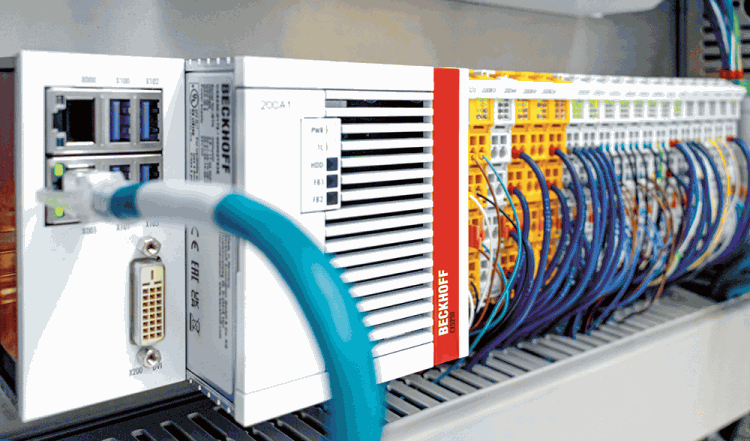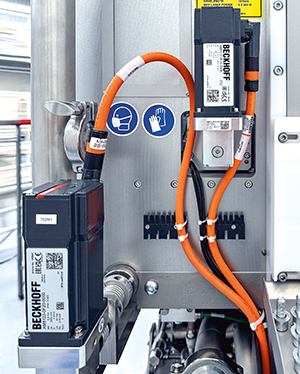
As an open control platform, PC-based control supports different engineering approaches, including low-code programming with frameworks such as Cordis SUITE. Machine builder, Additive Industries, uses this to create the code for the TwinCAT runtime of its MetalFAB 3D printers. When it comes to automation technology, the company relies entirely on Beckhoff controls, I/Os and drive technology.

Low-code programming, which refers to software development based on models in a graphical environment, is a long-established approach in IT. Cordis applies this approach in its Cordis SUITE platform for OT systems, where the code for the TwinCAT runtime is automatically generated from state machines and activity diagrams.
Open, right from the start
“Low-code programming started much later in OT than it did in IT because traditional manufacturers shielded their hardware for a long time,” explains Jan Peter Meeuwse, chief operating officer of Cordis. PC-based control from Beckhoff, on the other hand, was open, flexible and scalable right from the start. “Although the models developed with Cordis SUITE can also be transferred to other platforms, our customers stay with Beckhoff because of the unique advantages that PC-based control offers,” says Stefan van Amerongen, product lifecycle architect at Additive Industries.
Based in Eindhoven, Additive Industries uses Cordis SUITE to create the software for its MetalFAB industrial 3D metal printers. The company uses Beckhoff’s powerful hardware and software as its automation platform, a CX5230 embedded PC as the control platform, AX5000 servo drives to control the AM8000 servomotors, and a large number of EtherCAT and TwinSAFE terminals. “We chose Beckhoff as our system supplier because of the reliability and flexibility of the components. The comprehensive Beckhoff portfolio covers a broad spectrum and fits the modular architecture of our machine concept,” says van Amerongen.

Compact and precise drive technology
According to Additive Industries, the MetalFAB range offers the most advanced 3D printers for metals and achieves the highest productivity in its category due to its high degree of automation. “The drive technology and motion control from Beckhoff play an indispensable part in this, with reliability and durability that keep the printers’ productivity high,” says van Amerongen. In order to achieve excellent standards of surface quality in 3D printing, drive technology that is both precise and dynamic is required to move the buildplates during the printing process. AM8000 servomotors are also responsible for dispensing the metal powder, a process that is crucial for forming precise contours. In addition, the servomotors are used in automatic handling of the buildplates by robots. On average, fourteen servomotors are installed in each 3D printer.
The codebase of the 3D printer consists of around one million lines of code, of which Cordis SUITE generates more than half. This PLC code is maintained with just two to three people, whereas the remaining PC code requires a team of ten.
Low-code engineering embedded in TwinCAT
The single-button deployment concept in Cordis SUITE supports simple rollout of the software and seamless integration of the application into TwinCAT. The TwinCAT runtime combines the PLC, HMI, motion control and image processing. “This does away with the need for additional systems,” explains de Bruin, sales engineer at Beckhoff Netherlands. In addition, Additive Industries benefits from the advantages of open standard PC technology with operating systems such as Windows or Linux, and familiar interfaces with the machine and information systems. Meeuwse explains: “Our low-code development layer is supplemented by a generic server application that acts as a bridge between IT and OT systems, facilitating the integration of TwinCAT applications with the end users’ IT systems, and simplifying comprehensive data logging.”
Easy data integration into IT systems is important for Additive Industries, as most customers want to monitor the 3D printers. “The aerospace and automotive industries, for example, need this data for the certification and traceability of their products,” says de Bruin. Traditional tools can extract sensor data from the process and generate diagrams. Cordis SUITE goes one step further in this case and also displays the historical states of all components, or creates comprehensive logs that show the runtime behaviour of the software. “This gives a deeper insight into the internal workings of the software and turns the system into an intelligent sensor that provides a wealth of additional machine data,” says Meeuwse.
| Tel: | +27 11 795 2898 |
| Email: | [email protected] |
| www: | www.beckhoff.com |
| Articles: | More information and articles about Beckhoff Automation |

© Technews Publishing (Pty) Ltd | All Rights Reserved